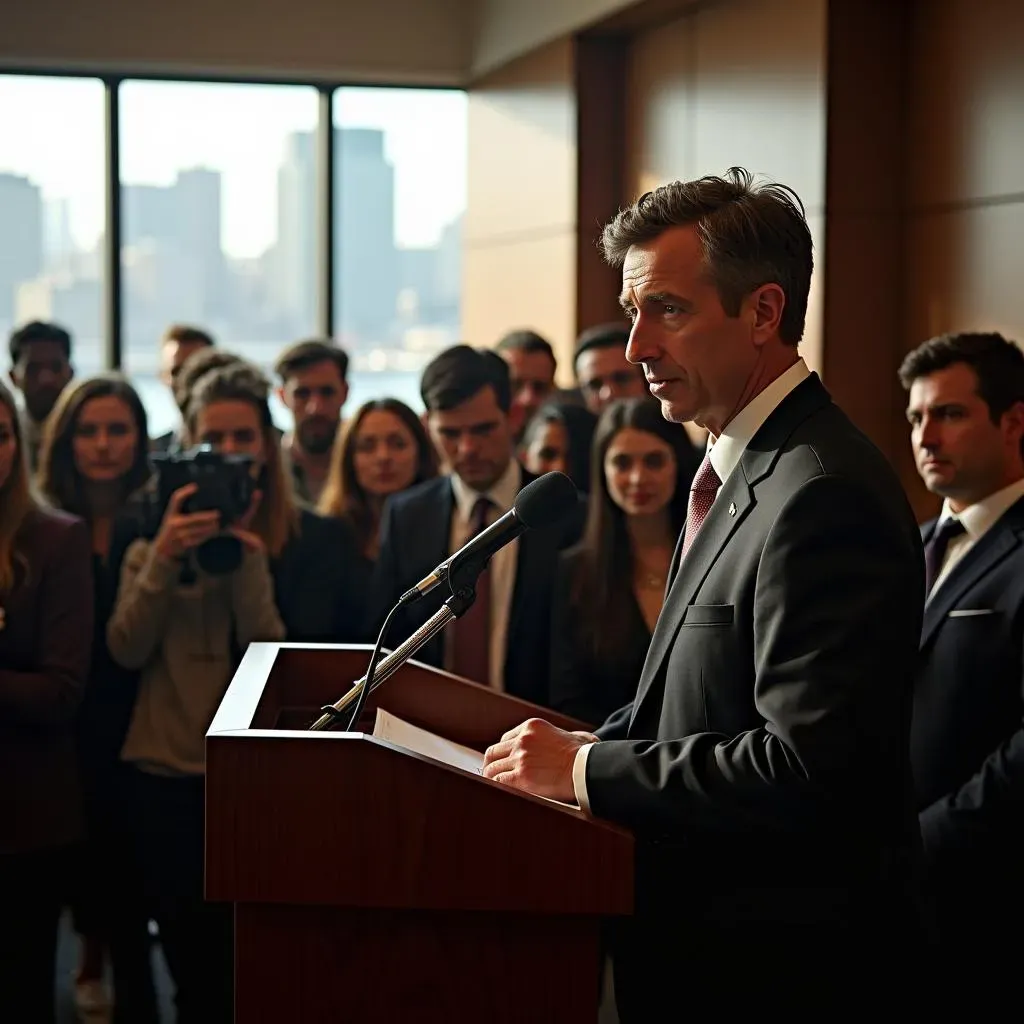Table of Contents
Ever wondered how celebrities navigate the stormy seas of public scandal? We all love to gossip about the latest celebrity mishap, but have you ever stopped to think about the strategies they employ to survive the fallout? This article dives into the fascinating world of celebrity crisis management, exploring the intricate techniques used to weather the storm. We'll examine the crucial role of public relations, analyzing how carefully crafted statements and strategic media appearances can shape public perception. Then, we'll dissect the art of the apology – when it works, when it backfires, and the delicate balance celebrities must strike between owning up to mistakes and protecting their image. Finally, we'll look at the long road to recovery, exploring how celebrities rebuild their reputations and reclaim their careers after a scandal. Get ready to uncover the secrets behind how celebrities handle scandals, a process often more calculated and strategic than you might imagine. Understanding "how do celebrities handle scandals" gives us a glimpse into the often-hidden world of reputation management and its powerful impact.
Damage Control: The PR Machine in Action

Damage Control: The PR Machine in Action
Spinning the Narrative
When a scandal hits, a celebrity's PR team springs into action. Think of it like a well-oiled machine, ready to deflect, distract, and ultimately, reshape the narrative. They'll carefully craft statements, aiming to control the flow of information and minimize negative impact. This often involves releasing carefully worded press releases, coordinating with media outlets, and managing the celebrity's social media presence to present a specific image. Sometimes, they'll even leak controlled information to friendly journalists, hoping to bury less favorable stories. It's a high-stakes game of chess, where every move is calculated to protect the celebrity's reputation.
For example, consider how a celebrity might handle allegations of infidelity. Instead of outright denial, a carefully planned statement might emphasize the importance of family, express regret for causing hurt, and request privacy. This approach avoids direct confrontation while acknowledging the issue and attempting to appeal to public sympathy. The goal isn't necessarily to erase the scandal but to mitigate its long-term damage. A good PR team understands the power of carefully chosen words and strategic timing, knowing that a well-executed damage control plan can make all the difference.
Strategy | Goal | Example |
|---|---|---|
Controlled Leaks | Shift focus to a more positive story | Leaking details of a charity event to distract from a minor controversy. |
Public Apology | Show remorse and regain public trust | A sincere apology for offensive remarks. |
Social Media Silence | Avoid further fueling the fire | Temporarily deleting social media accounts to prevent further negative comments. |
The Power of Image Management
Beyond crafting statements, a crucial part of damage control is meticulous image management. This involves controlling the images and information that are publicly available. Think carefully staged paparazzi photos, or a celebrity strategically choosing to appear at a charity event to show their good side. They might even work with fashion stylists to curate a new, improved public image, showcasing a renewed sense of responsibility or maturity. In today's social-media-saturated world, image management is incredibly important; a single poorly-chosen Instagram post can undo weeks of careful PR work. This aspect often involves collaborating with social media influencers, which can be an effective strategy to counter negative narratives.
Consider the example of a celebrity facing accusations of reckless driving. Their PR team might work to portray them as a changed person, highlighting their recent contributions to traffic safety campaigns or their participation in community service initiatives. This helps to counter the negative image and replace it with a more positive one. It's about actively shaping public perception and presenting a narrative that aligns with their desired image. Remember, a celebrity's reputation is their most valuable asset, and protecting it requires a multifaceted approach.
- Strategic use of social media
- Controlled photo opportunities
- Collaboration with positive influencers
The Importance of Timing
Timing is everything in damage control. A swift, decisive response is often the best approach. Delaying a response can allow rumors and speculation to run rampant, making the situation harder to manage. A quick, well-crafted statement can show accountability and prevent the story from escalating. However, rushing into a poorly-considered response can also be disastrous. It's a delicate balance between acting quickly and acting thoughtfully. The PR team needs to carefully assess the situation and develop a strategy that considers all possible angles before taking any action. A poorly timed response can often make the situation worse.
For instance, a celebrity caught in a minor controversy might choose to ignore it completely, hoping it will fade away. However, a more serious accusation requires an immediate and carefully considered response. The key is to understand the gravity of the situation and tailor the response accordingly. Sometimes, silence is golden; other times, it’s a recipe for disaster. This is where experience and expertise in PR are invaluable. Knowing when to speak, when to stay silent, and how to craft the perfect message can be the difference between a minor setback and a career-ending scandal. Learn more about how celebrities maintain privacy to understand the broader context of image control.
The Apology: A Calculated Risk

The Apology: A Calculated Risk
The Sincerity Factor
An apology isn't just about saying sorry; it's about showing sincerity. A heartfelt apology, delivered with genuine remorse, can go a long way in repairing damaged trust. Celebrities often work with crisis communication experts to craft apologies that feel authentic and address the specific concerns of the public. This might involve acknowledging the hurt caused, taking responsibility for actions, and outlining steps to prevent similar incidents in the future. A poorly delivered apology, however, can make matters worse, so it’s crucial to get it right.
Think of how a celebrity athlete might apologize for a doping scandal. A simple "I'm sorry" won't cut it. A genuine apology would likely include an admission of guilt, an explanation of the circumstances (without making excuses), and a commitment to never repeat the offense. The athlete might also participate in anti-doping campaigns to demonstrate their commitment to change. The key is demonstrating genuine remorse and taking concrete steps to make amends. Learning how celebrities connect with fans can offer insights into building and rebuilding trust.
- Acknowledge the hurt caused
- Take responsibility for actions
- Outline steps to prevent recurrence
Strategic Timing and Delivery
The timing and delivery of an apology are just as important as its content. A prompt apology shows accountability and prevents the scandal from festering. However, rushing into an apology before fully understanding the situation can be counterproductive. The apology should be delivered through the appropriate channels—a press conference, a social media post, or a personal statement—depending on the nature and scale of the scandal. The goal is to reach the target audience effectively and efficiently. A well-timed and well-delivered apology can prevent further escalation.
For example, a celebrity involved in a minor traffic accident might issue a brief apology on social media, while a more serious offense might warrant a formal press conference. The chosen method should match the severity of the offense. Furthermore, the celebrity's demeanor during the apology is crucial. A genuine, humble apology is more effective than a defensive or arrogant one. The way a celebrity handles their image is vital, and you can find out more by reading about how celebrities maintain their privacy.
Scenario | Best Apology Method | Considerations |
|---|---|---|
Minor Offense | Social Media Post | Keep it brief, sincere, and focus on taking responsibility. |
Serious Offense | Press Conference | Prepare a detailed statement addressing all aspects of the situation. Allow for questions. |
Beyond the Words: Actions Speak Louder
An apology is only as good as the actions that follow it. A celebrity's post-apology behavior is carefully scrutinized by the public. Continued positive actions, such as charitable work or community involvement, can help to demonstrate genuine remorse and rebuild trust. Conversely, further missteps can undermine the effectiveness of the apology and prolong the negative publicity. Sustained positive behavior is key to long-term reputation repair.
For instance, a celebrity convicted of drunk driving might volunteer their time at a Mothers Against Drunk Driving (MADD) chapter or participate in public awareness campaigns. These actions demonstrate a commitment to change and help to counter the negative image associated with the offense. It's about showing, not just telling. It's about demonstrating genuine commitment to growth and positive change. To learn more about how celebrities make amends, check out this related article on how celebrities handle scandals.
LongTerm Recovery: Rebuilding a Reputation

LongTerm Recovery: Rebuilding a Reputation
The Long Haul: Rebuilding Trust
Rebuilding a reputation after a scandal is a marathon, not a sprint. It requires sustained effort, consistent positive actions, and a genuine commitment to change. Celebrities often engage in extensive community service, participate in charitable causes, and actively seek opportunities to demonstrate their growth and remorse. This might involve working with organizations aligned with the nature of their past mistakes, showcasing a commitment to making amends. It's about consistently demonstrating positive character and proving that past actions don't define their future. Remember, rebuilding trust takes time, patience, and consistent positive actions.
Think of a celebrity who's overcome a substance abuse issue. Their road to recovery might involve attending support groups, speaking publicly about their struggles, and becoming an advocate for addiction awareness. These public displays of commitment show their willingness to grow and to help others, making them a more relatable and sympathetic figure. This sustained effort to improve themselves and help others is what ultimately helps them regain public trust. To understand how celebrities navigate their personal lives, you might find this article on how celebrities maintain privacy helpful.
- Community Service
- Charitable Work
- Public Advocacy
Strategic Career Moves
Sometimes, a career shift can be a strategic move in rebuilding a reputation. This might involve taking on roles that showcase a different side of their personality or talent, or focusing on projects that align with their newfound values. For instance, a celebrity known for controversial behavior might choose to focus on more family-friendly projects, demonstrating a commitment to a more responsible public image. This can be a powerful way to subtly shift public perception and signal a desire for positive change. A strategic career change can help them leave the past behind and focus on their future.
Consider a celebrity actor known for playing villainous roles who's embroiled in a scandal. They might choose to take on roles in family films or dramas that showcase their ability to portray depth and compassion. This allows them to demonstrate versatility and maturity, helping to distance themselves from their previous negative image. A thoughtful career transition can be a powerful tool for rebuilding a tarnished reputation. This aspect is closely linked to how celebrities pick roles, showcasing their strategic thinking.
Strategy | Example | Impact |
|---|---|---|
Shifting Genre | Action star taking on dramatic roles | Demonstrates range and maturity |
Focusing on Independent Films | Moving away from mainstream blockbusters | Suggests a desire for more artistic expression |
The Power of Time and Consistent Behavior
Ultimately, the most effective tool for rebuilding a reputation is time and consistent positive behavior. Years of consistent positive actions can gradually outweigh past mistakes in the public's mind. This means maintaining a positive public image, consistently engaging in positive activities, and avoiding any further missteps. It's a long-term commitment to demonstrating growth, responsibility, and a genuine desire to make amends. In the end, consistent good behavior speaks louder than any apology.
It's important to remember that rebuilding a reputation is a long and arduous process. There's no magic bullet, no quick fix. It requires consistent effort, genuine remorse, and a willingness to learn from past mistakes. The public is watching, and consistent positive behavior is the key to regaining their trust. For insights into the long-term aspects of a celebrity's career, explore when celebrities retire.